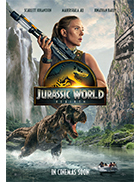Jurassic World: Rebirth
|  Jurassic World: Rebirth, the seventh film in the decades-spanning franchise that began with Steven Spielberg’s blockbuster 1993 adaptation of Michael Crichton’s ready-for-the-screen novel Jurassic Park, goes full monster movie. Of course, all of the previous films in the series were monster movies of a sort, but Rebirth takes it one step further by discarding the notion that the rampaging monstrosities are simply extinct animals resurrected by the science of DNA in the wrong time and place and instead posits them as genetically engineered freaks, mixed-and-matched dino-atrocities that bear little resemblance to the creatures kids read about with awed fascination. The series has been edging in this direction since Jurassic World (2015), but even then the focus was primarily on recognizable dinosaurs with one distorted horrorshow waiting for the climax. In Rebirth, virtually all the creatures are horrorshows, and when something familiar like a T-Rex or a velociraptor shows up, it almost feels like the cameo appearance of an aging star on his last go-round. For those who may not remember, the Jurassic World trilogy ended with dinosaurs essentially living side by side with humans. Well, screenwriter David Koepp, a returning veteran of the series who wrote the screenplays for both the original Jurassic Park and its sequel The Lost World (1997), clearly didn’t want to follow that storyline, so it is immediately established that pretty much all of the dinosaurs in the world are dying because they simply aren’t attuned to the climate of the early 21st century. The only ones who have survived are ones living on remote islands around the equator where the terrain and climate is much more Jurassic in nature, although they are absolute no-go zones for any and all humans. Of course, a no-go zone in a Jurassic World movie is just an invitation to court disaster, which is precisely what Koepp gives us with Martin Krebs (Rupert Friend), a greedy pharmaceutical executive who wants to create cutting-edge new drugs using the DNA from dinosaur blood. The problem is that the blood has to be retrieved from a living dinosaur, and the blood he needs just happens to come from three of the biggest dinos out there: Mosasaurs, Titanosauraus, and Quetzalcoatlus. So, he hires a crack team of professional mercenaries led by Zora Bennett (Scarlett Johansson) and Duncan Kincaid (Mahershala Ali), with intellectual support from Dr. Henry Loomis (Jonathan Bailey), a paleontologist making his first foray into the field. And, because it just wouldn’t be a Jurassic Park/World film without children in danger, the team first has to rescue a family—a father (Manuel Garcia-Rulfo), teenage daughter (Luna Blaise) and her slacker boyfriend (David Iacono), and adolescent daughter (Audrina Miranda)—from their sailboat that has been capsized by a Mosasaurs, which means they are along for the dino-hunt. The hunt itself takes place on an island where InGen, the company that engineered the dinosaurs, was engaging in its most dangerous genetic experiments, all of which were left to fend for themselves on the island. If there was something fundamentally tragic about dinosaurs being ripped out of extinction and dropped in a world where they don’t belong, the mutated creatures in Rebirth are even more tragic given that they don’t even have nature to fall back on, just gene splicing and the twisted human desire to create things God never intended to walk the earth. To give the film a bit of a softer edge, we are introduced to a cute little dinosaur named Delores, who is there to remind us that not all genetic experimentation results in abject terror (just most of it). Visual effects artist-turned-director Gareth Edwards, who helped reinvigorate the giant monster genre with Godzilla (2014) and also directed Rogue One: A Star Wars Story (2016), most recently helmed the humans-vs-artificial intelligence sci-fi thriller The Creator (2023). He knows his way around big set-pieces, and he delivers a number of stand-out moments in Rebirth. He clearly recognizes the need to lean more heavily on the horror elements, and he finds a nice balance between suspenseful sequences, some of which heavily mirror the best moments in Spielberg’s films, with grand-slam moments of enormous power and violence. He saves the film’s biggest, baddest dinosaur—the appropriately named Distortus Rex—for the climax (although it makes a brief appearance in the film’s 17-years-earlier prologue), and the manner in which Edwards allows it to emerge from swirling, red-lit mist like a nightmare coming to life has a ferocious power all of its own. The characters tend to be a bit formulaic, although the backstory tragedies suffered by Zora and Duncan give their otherwise one-note action personas a bit more depth, as does their gradual recognition that money is not the end-all-be-all of existence and that the medical secrets unlocked from the dino blood might be better for the whole world if it doesn’t wind up in the labs of a massive pharmaceutical corporation. As it turns out, Big Pharma is much more horrifying than any genetically spliced dino concoction, regardless of how many teeth and claws it wields. Copyright © 2025 James Kendrick Thoughts? E-mail James Kendrick All images copyright © Universal Pictures / Amblin Entertainment |
Overall Rating: 

 (3)
(3)


